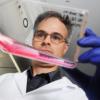I have an idea that selegine extends life by extending neuronal lifespan in hypocampus and thus delaying glycocorticoid dysregulation onset by age. The process is following:
1. the hypothalamus releases corticotropin-releasing hormone (CRH)
2. CRH stimulates the release of ACTH from the anterior pituitary
3. ACTH causes the release of glycocorticoids from the adrenal cortex
glycocorticoids:
*supress immunsystem
*Increase catabolism of protein
*Supress libido
*Supress tissuerepair ability
*Increase blood glucose
*Decrese growth
*Could injure and kill nervcells
+many decrimental effects
Levels of glycocorticoids are higher in old people and animals probebly due to dysregulation of the loop by neuronal death in hypocampus. The process is controlled by an autoregulatory loop. High levels of glycocorticoids could kill the neurons in hypothalamus regulating the levels of glycocorticoids themselves thus leading to even more dysregulation. Selegine protects neurons from death by an unknown process extending life of rats by up to 20%. I suspect the protection of hypothalamic neurons could be important since the neurons there seem control so many functions associated to aging.
The phenoptosis which happen to salomons after mating is due to total glycocorticoid dysregulation. If aging is to at least some extent similar to this phenoptosis it opens up for pharmacological interventions in the process.
Edited by wolfram, 12 May 2005 - 12:08 PM.











































